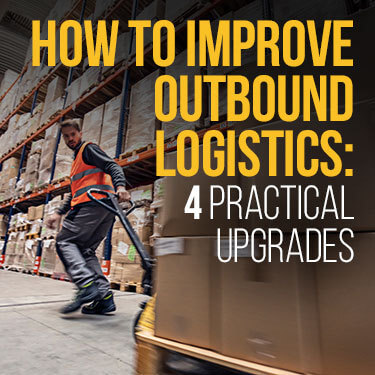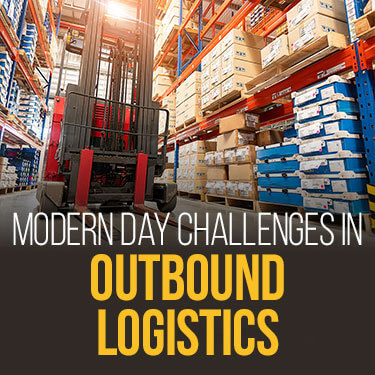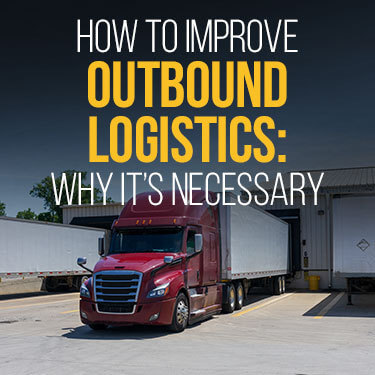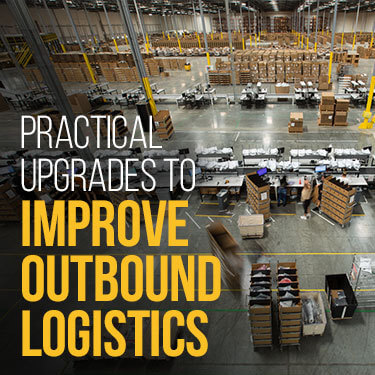
 Copy URL to Clipboard
Copy URL to Clipboard
Figuring out how to improve outbound logistics impacts a very visible part of your supply chain. It also happens to be one of the most rapidly changing parts of the shipping industry. A rise in B2C sales due to eCommerce and the online platforms of retail giants continues to drive innovation at all levels.
Optimizing outbound logistics means finding a balance between customer needs and practical action. Four upgrades that can be of use are:
Making smart investments now puts you on track for future growth.
Learn more about putting these upgrades into place and how they can prove beneficial to your company and customers.
Table of Contents
Outbound logistics are the final links in the supply chain that prepare and ship goods to their final destination. The final logistics look a little different from company to company, mostly when comparing B2B to B2C services.
In simple terms, outbound logistics refers to the process where goods are sorted, packed, shipped, and delivered to the customer. The customer delivery aspect is known as final mile service.
Depending on where your company operates on the global supply chain, your outbound logistics operations might be someone else’s inbound logistics processes. This is more true if you work with raw materials in creating finished products.
For example, if your company manufactures leather goods, your inbound services may include raw cowhides. Your outbound logistics management would be focused on getting your finished products to retail stores or a distribution center being used by an eCommerce retailer.

Outbound logistic processes looked the same for many years. When in-store purchases were dominant, B2B industries would pack their pallets, get trucks loaded, deliver to stores, and be done. There would have been very little contact with the direct customer aside from the occasional direct delivery.
The rise of the eCommerce industry coupled with expectations for faster delivery means the old way of doing things just isn’t enough.
Modern challenges have highlighted the importance of outbound logistics.
The rising importance of customer satisfaction has played a role in some of these challenges. With so many options now available to potential clients, many companies feel the need to increase the variety and volume of their goods.
Without proper management processes in place, however, inbound and outbound logistics can become overwhelmed with such variety. It's better to find ways to work smarter rather than harder.

Knowing what the challenges to the industry are, you can plan out strategies specific to your business needs.
Why is this so necessary? Consider the impact each separate challenge can have on the overall industry. For instance, limited warehouse availability. Some great companies have started in garages, but they didn’t stay there.
For someone trying to grow their eCommerce business, finding a warehouse or distribution center that can take some of the inventory load is crucial. When space is limited, what is available comes at premium costs per square foot.
Let’s look at one of the most crucial warehouse districts in the United States - California’s Inland Empire. Warehousing near major West Coast Ports, specifically those on San Pedro Bay, has become almost impossible to find. Vacancy rates in the region have dropped dramatically in the last few years.
| Year | Vacancy Rate |
| 2016 | 4% |
| 2017 | 3.7% |
| 2018 | 3.7% |
| 2019 | 3.6% |
| 2020 | 1.9% |
| 2021 | 0.7% |
After having a steady vacancy rate that hovered around 3.5% from 2016 to 2019, things took a sharp turn down. The vacancy rate is now less than 1% and efforts at creating more space are limited. Those who do find space are paying, on average, 67.2% more per square foot than in previous years.
Out of sheer necessity, you need to learn how to improve outbound logistics to make growth possible.

Saying that you need to improve your outbound logistics management and actually doing so are two different things. While there are many strategies to achieve optimization, let’s focus on a few practical upgrades.
Implementing these improvements may come at significant initial costs, depending on how and to what extent to utilize each one. In the long run - these improvements are going to pay for themselves but each business needs to evaluate its resources and see what is and isn’t practical for its current circumstances.
Inventory storage and management is something of a middle point between inbound and outbound logistics. Accurate inventory is needed so you know when to order more and how much you still have available to sell.
As a business grows, so does inventory complexity. While there may have been a time when a handy spreadsheet and a weekly hand count were all you needed, things have changed.
With an Order Management System (OMS), you have the ability to automate these processes and get real time number updates. There are different levels of OMS, often customizable to your business needs. An OMS is often at the core of a strategic warehousing plan.
Track different metrics depending on your needs.
Not only will an OMS allow you to get a transparent view of your operation, but it will also give you access to valuable data. The ability to generate reports to track most ordered items, average fulfillment speed, and more means you gain insight into trends in real time.
Healthy customer relationships are good for business. If you’ve already taken the time to optimize your inbound logistics, then you already know how important building supplier relationships is. The same things you appreciate about a good supplier are appreciated by your customers too.
At the core of an ideal customer experience is the availability of clear and transparent communication. This doesn’t mean a bombardment of constant emails, but rather focused messages relevant to customer orders.
Some OMS systems have mobile options that allow messages to be shared directly with customers via text or an app specific to your company. Other times you can integrate an existing app with a warehouse management system.
Useful information and services to provide for customers could include:
The easier it is for customers to find out what’s going on with their orders, the more satisfied they are. Even if you can’t always provide the fastest service, being upfront about delivery times - even if it takes weeks - is better than promising a rapid service you can’t follow through with.
Another significant digital upgrade for your business is to begin using an Electronic Data Interchange (EDI) system. Where OMS and customer communication tools are meant to stay internal, an EDI streamlines communication between you and any outbound logistics business partners.
Depending on whether your focus is B2B or B2C, this could mean direct customers or the shipping service you use for final services. Either way, an EDI is intended to provide an electronic and structured system for the exchange of business documents.
An EDI is not meant to replace an OMS or other management tool used to store your data. It is a bridge between communication systems. At its most sophisticated, it can entirely eliminate the need for paper-based exchanges between companies.
Because it can integrate with your current OMS, it serves as an instant communication tool. Do you have customers asking delivery drivers for updates on other packages? If you are using EDI, that driver may be able to check the status of orders even if functioning as a separate company or contract service.
There are multiple types of EDI services to choose from depending on your needs and budget.
Each type of EDI System has its pros and cons. Likewise, putting an EDI into practice requires your company to have an existing OMS or WMS system in place to hold and manage the data.
Once you do have an EDI system in place, communication with business partners and clients should be clearer across the board. In some cases, you may even be able to provide timed deliveries within a 15-minute window.

Finally, you can choose to expand your business by partnering with a Third Party Logistics company, or 3PL. Much like any warehouse management system or EDI, there are various levels of service depending on what kind of 3PL you go with.
For the most part, even the most basic 3PLs provide some kind of warehouse management service and help you find carriers to pick up and distribute your goods. Choosing a 3PL provider is a big step, especially when you might be used to controlling so many parts of your logistics operations directly.
Do your research and be sure to choose a proven company that has a good track record of warehouse management and can properly vet carriers to ensure your goods are safe in transit. If you need special services provided, such as pick and pack, make sure your chosen 3PL can offer those services.
The added benefit of outsourcing your outbound logistics to a 3PL, at least for some storage and distribution needs, allows you to take advantage of the technology you may not otherwise have access to. These technologies can then relieve some of the burdens personally of figuring out how to improve outbound logistics.
A 3PL can provide services because they often move multiple goods from different companies. Experience is on their side for many factors.
As online markets continue to grow with current consumer practices, using a 3PL gives you the ability to grow local and possibly nationwide sales.
Want to learn more about how a 3PL handles different sides of the supply chain? Check out our article on procurement vs logistics.
Customers expect more than ever from retailers, from multiple payment options to play-by-play delivery notifications. R+L Global Logistics can be your 3PL partner as you grow and expand your business.
As an industry leader for many years, we have the experience necessary to handle your distribution needs from multiple warehouses across the country. We have cross dock and transload services available to get your shipments where they need to go.
We vet our carriers closely and have been working with some for many years. Learn how to improve outbound logistics today and watch business soar.
Speak with a representative directly at (866) 989 - 3082 or request an online services quote today.
